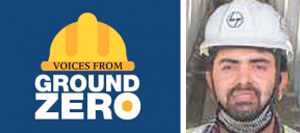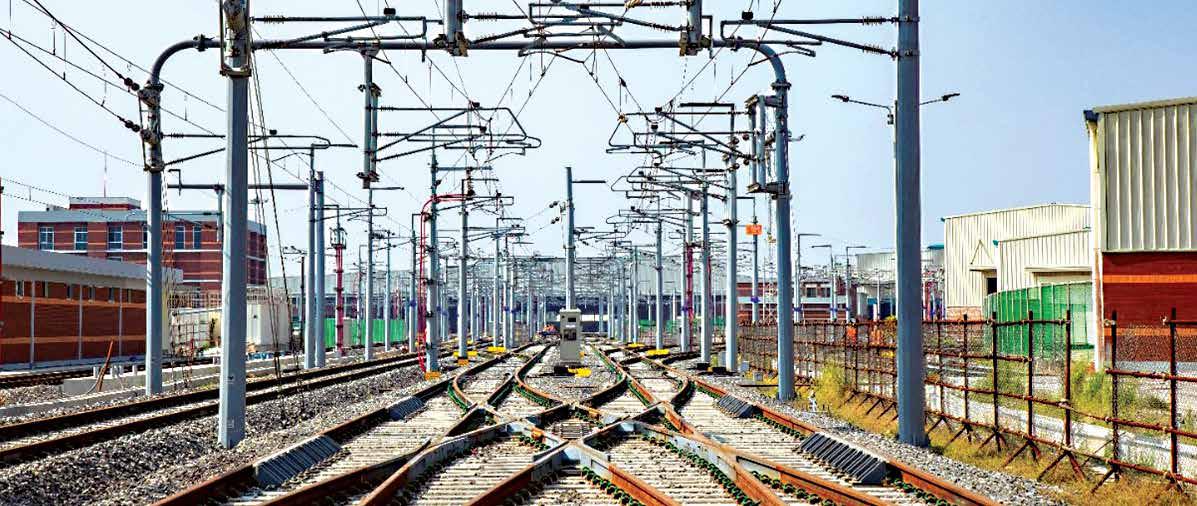TWO RAILWAY SBG PROJECTS
FORGE SPEEDILY AHEAD
The Dhaka Metro CP07 design & build composite project is amongst the top 5 fast track projects being executed in Bangladesh and acknowledging this recognition, Project Director, Ashish Gupta, and his project team supported the Government of Bangladesh in celebrating the golden jubilee of their Victory Day by opening a section of the first phase of the project for a test run that was roundly appreciated by all stakeholders. The project is the first out of six Mass Rapid Transit (MRT) lines planned by the Bangladesh Government and is a 20 RKM MRT line to be completed in two phases: Phase 1 – Depot to Agargaon (11.1 RKM Mainline and 19 TKM Depot) and Phase 2 – Agargaon to Motijheel (8.9 RKM Mainline).

THE DHAKA METRO STORY THUS FAR
Having started in July 2018, the project has made significant progress and achieved critical milestones despite the challenges and complexities of executing in a foreign land, viz. different laws, and work culture, interacting with expatriates, including the Engineer, who are predominantly Japanese and also dealing with contractors from Thailand, Japan, USA, China & Bangladesh. “The good thing is that we are certainly on the same page as our client and all other stakeholders, which is primarily the reason why we have been able to comfortably meet all our key project dates,” remarks a confident Vice President and Head – Metro BU, RBG Sunil Khattar.

“The good thing is that we are certainly on the same page as our client and all other stakeholders, which is primarily the reason why we have been able to comfortably meet all our key project dates.”
RBG Sunil Khattar
Vice President and Head – Metro BU
Ashish is happy with his team’s comprehensive project planning and scheduling with advanced project management tools. “The accesses to the viaduct, stations and depot are updated on a real-time basis in the project schedule and our prominent look ahead plan keeps us on target for resource and manpower engagement,” he informs, “and helped us maintain a lean organization structure and asset light project management.”
CRACKING THE CODE FOR PROMPT MATERIAL DELIVERY
Import of metro rail material & equipment from across the globe was happening for the first time in Bangladesh and was new to the local Customs officers. The result was excessive inspection time and inordinate delay in deliveries. L&T’s personnel stepped in to familiarise the local officers on the project to streamline and quicken the process. The team’s real-time schedule triggers material requirements, which is most helpful as most of the materials are imported. “One of the biggest challenges for the project was transportation of Ballast from India,” shares Ravi Sehrawat, Planning Manager (Track). “The client initially insisted on getting the Ballast from Pakur, from where the deliveries were extremely slow due to multiple handling and several land border restrictions. Hence, we convinced the client to procure the material from Vizag, which has helped us rapidly execute the Depot Track.”

“One of the biggest challenges for the project was transportation of Ballast from India. The client initially insisted on getting the Ballast from Pakur, from where the deliveries were extremely slow due to multiple handling and several land border restrictions. Hence, we convinced the client to procure the material from Vizag, which has helped us rapidly execute the Depot Track. ”
Ravi Sehrawat
Planning Manager (Track),
Dhaka Metro Project
SOLVING THE LABOUR ISSUE
Bangladesh Railways do not have an Overhead Catenary System (OCS), so the team could not expect local support for two of the most labourintensive works – track work and OCS. The issues before them were that getting all the workmen from India was uneconomical, the deployment foreigners in the project was restricted and expats came at a high cost. The answer lay in a hybrid model of bringing only the vital members for these works from India, to work with local labour to start with and gradually increase the workload of the locals as their learned and trained on the job. “This worked perfectly as per plan and our productivity set new benchmarks,” smiles Sunil.

“The accesses to the viaduct, stations and depot are updated on a real-time basis in the project schedule and our prominent look ahead plan keeps us on target for resource and manpower engagement and helped us maintain a lean organization structure and asset light project management.”
Ashish Gupta
Project Director, Dhaka Metro Project
ENSURING THE RIGHT KIND OF PARTNERS
Another challenge was that none of the equipment manufacturers were on board at an early date. Secondly, the civil and rolling stock contracts had been awarded to them much earlier and hence their works were in an advanced stage. “The interfacing contractors were thus expecting instant solutions from us,” Ashish points out, “however, our technical experts with their inherent knowledge of the subsystems did a pretty good job to provide information on time, and the employer too was satisfied with the rapid pace of involvement in the project.” Ravi was given additional responsibilities as an Interface Manager, handling the key access and design interface for Track, OCS, Power Supply, Signalling, Telecom, Lift & Escalator, Automatic Fare Collection and Platform Screen Doors. “We addressed our issues through clear and structured communication, which helped us to get early access to the viaduct and stations,” he says.

Depot Track & OCS
COVID-19 DISRUPTIONS
A 66-day lockdown of the country disrupted road, air and sea connectivity. Labour shortage and widespread infections forced the team to reassess and recalibrate their project plans according to the new COVID protocols, by adopting mitigation measures like setting up quarantine centres, improving the medical facilities and enforcing stricter working norms. Ashish feels that the project stood up very well to the test, with the team even guiding their partners in the process. “We closely co-ordinated with our civil contractors for access, putting across sequential priority-wise requirements for the viaduct and stations.” By sub-structuring their work plans, and making excellent use of the available resources, the team has good progress to show.

CRS inspection
SOME HIGHLIGHTS OF THE PROJECT

THE BENEFITS OF THE PANDEMIC
The adoption of virtual inspections has been a huge beneficial fallout of the pandemic for projects across the organization: they reduce travel costs and time, can be scheduled at short notice, ensure timely completion and, most importantly, without compromising on testing or quality. Some major virtual inspections conducted with foreign suppliers include for the Energy Storage System (ESS) with M/s Toshiba, Japan, which lasted over 5 days; for Cantilevers and ATDs with M/s Sanwa Tekki, Japan; for OCS masts/portals with M/s Valmont; for Control Cables with M/s Universal Cables, India; and for OPC suspension and strain clamps with M/s Mosdorfer. Section In-charge Mayil Rajkumar S specially mentions the critical TSS commissioning that had to be conducted using a HD webcam since the Secheron supervision team could not travel from Geneva (Switzerland) and India.
As Sunil, Ashish, Ravi and their team push forward to complete this challenging project, Mayil Rajkumar nicely articulates the team’s approach: Dream big, stay positive, work hard and enjoy the journey!
WORK FAST-FORWARDING AT THE
CORE EPC 7 PROJECT
The CORE EPC 7 project awarded by the Railway Electrification Project, Chennai, commenced contractually on 1st June 2020 at the height of the COVID wave, forcing the team to realign their execution plans. Their first step was to develop a 3-month ‘Look Ahead’ plan that sharply focused on progress and invoicing. “Our execution strategy involved a target of 50 foundations a day,” spells out Chief Project Manager Venkatesh M Nagabhushan, “opening multiple fronts for each activity to stretch our capabilities and sweat our P&M assets, helping us erect 100 masts at a stretch on several days.” While SWOT and cost-benefit analyses helped them stay ahead of delivery schedules, they closely monitored project progress vis-à-vis baseline planned in TILOS to review and resolve project constraints. “We had special drives like Mission 50×50 and Mission 75×75 (number of foundations per day × number of days at a stretch), concentrated on minimising indirect costs with speedy execution, dynamic shifting of specialized resources as per plans and creation of a central team that is responsible for allocating key resources including material planning and inventory management,” elaborates Venkatesh.

“Our execution strategy involved a target of 50 foundations a day opening multiple fronts for each activity to stretch our capabilities and sweat our P&M assets, helping us erect 100 masts at a stretch on several days.”
Venkatesh M Nagabhushan
Chief Project Manager,
CORE EPC 7 Project
All this pre-planning, however, did not prepare the team for the pandemicinduced disruptions. Lack of labour, breakdown of the supply chains, lack of industrial oxygen, heavy monsoons and infections impacted progress in a big way. To address them the team acted quickly and decisively. Labour was airlifted to meet critical milestones, and the team put in their efforts to complete activities like OHE foundation before the onset of the monsoon.

Scissor ‘X’ on the viaduct
MAJOR MILESTONES ACHIEVED

The team has successfully completed CRS Inspection of 312.1 TKM out of 1137 as on Dec 2021 and is targeting to commission a further 402 TKM by Q4 of FY 2022–23. Out of eight groups, three (Gr. 272, Gr. 271 B and Gr. 274) have been commissioned and handed over to the customer. In fact, the 215 TKM Gr. 272 (Cuddalore–Vriddhachalam– Salem) was commissioned within 18 months, winning the client’s appreciation. Nearly 40% of the substation work, which includes erection of 12 transformers out of the total scope of 16, is over, and nearly 35% of Signalling and Telecommunication works have been commissioned and handed over to the Railways for train operations.

“Our principle of First Time Right is what has helped us achieve so much progress,” shares Naresh Bandaru, Project Manager P2, “which has avoided rework and saved time and costs.” Citing some examples, Pawan Verma, Project Manager P1, shares that the brackets were fabricated only after grouting and based on measurements from site. They followed a stringent grouting procedure to ensure cantilever erection without adopter fitting at permitted locations. SED is prepared only after grouting measurement and cantilevers are fabricated with utmost accuracy, while quality checks are conducted by the site engineers before the cantilever is shifted from the fabrication yard. The procedures have reduced adjustment time and saved precious traffic block time during Tower Checking.
BENCHMARKING ACTIVITIES
OHE activities such as foundations, mast erection, CE & Wiring have been benchmarked to achieve their targets ahead of customer requirements. “The current industry trend in brown field railway electrification projects is an average of 25 foundations and 40 mast erections per day,” points out Chandan Kumar, Project Manager P3, “whereas we have consistently hit 40 foundations and erected more than 150 masts a day.”

Pollachi Yard
Kinnatukadav Yard

“The current industry trend in brown field railway electrification projects is an average of 25 foundations and 40 mast erections per day whereas we have consistently hit 40 foundations and erected more than 150 masts a day.”
Chandan Kumar
Project Manager P3,
CORE EPC 7 Project
CENTRAL TEAM FOR CRUCIAL ACTIVITIES
From the start, a central team was formed with specialized skillsets to manage activities such as central fabrication for structural steel works like height gauges, fencing panels, protective screens, etc. There is a central OHE team for wiring and power block works and another for PSI and P-Way works. These teams are used across sections, based on work requirements and scheduled planning, which has translated into significant cost savings and avoided idling of specialized resources.
Often it is the team that makes all the difference, and Venkatesh and his young, energetic team, ably directed by Akula S Phanendra Kumar, have been instrumental in implementing First time right principles in the project to speedily push the project towards completion by 18th February 2023.